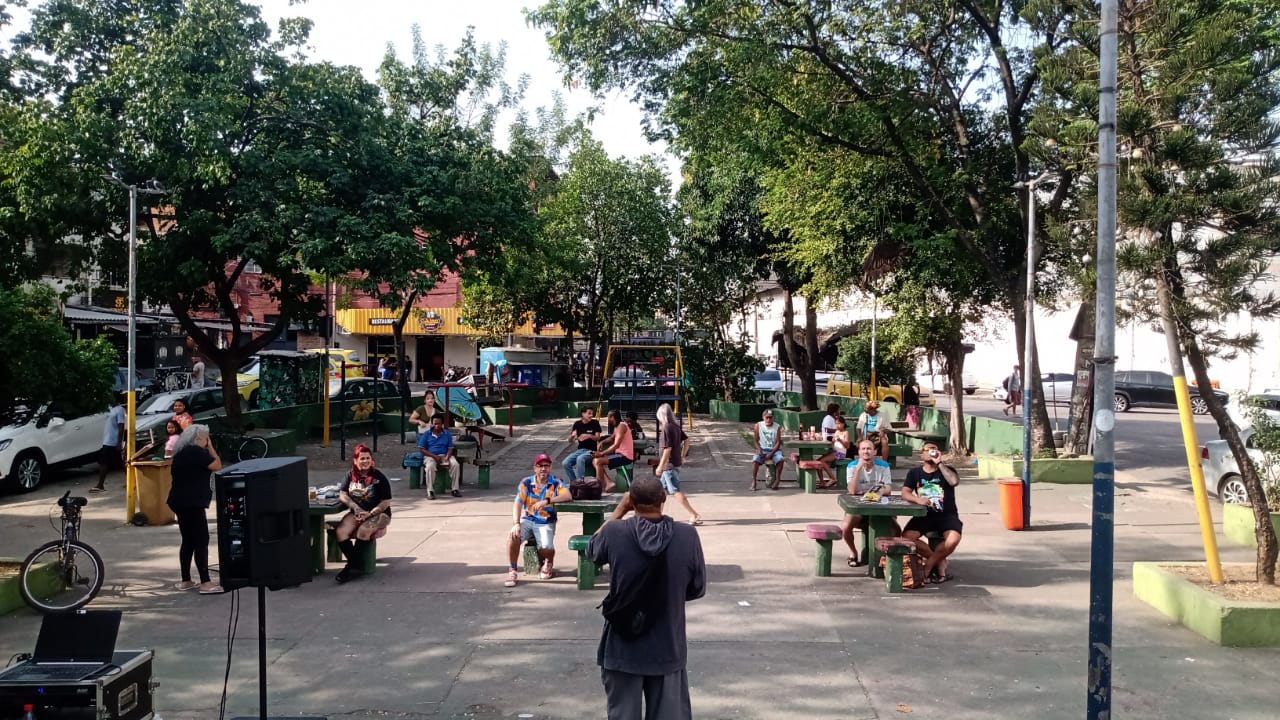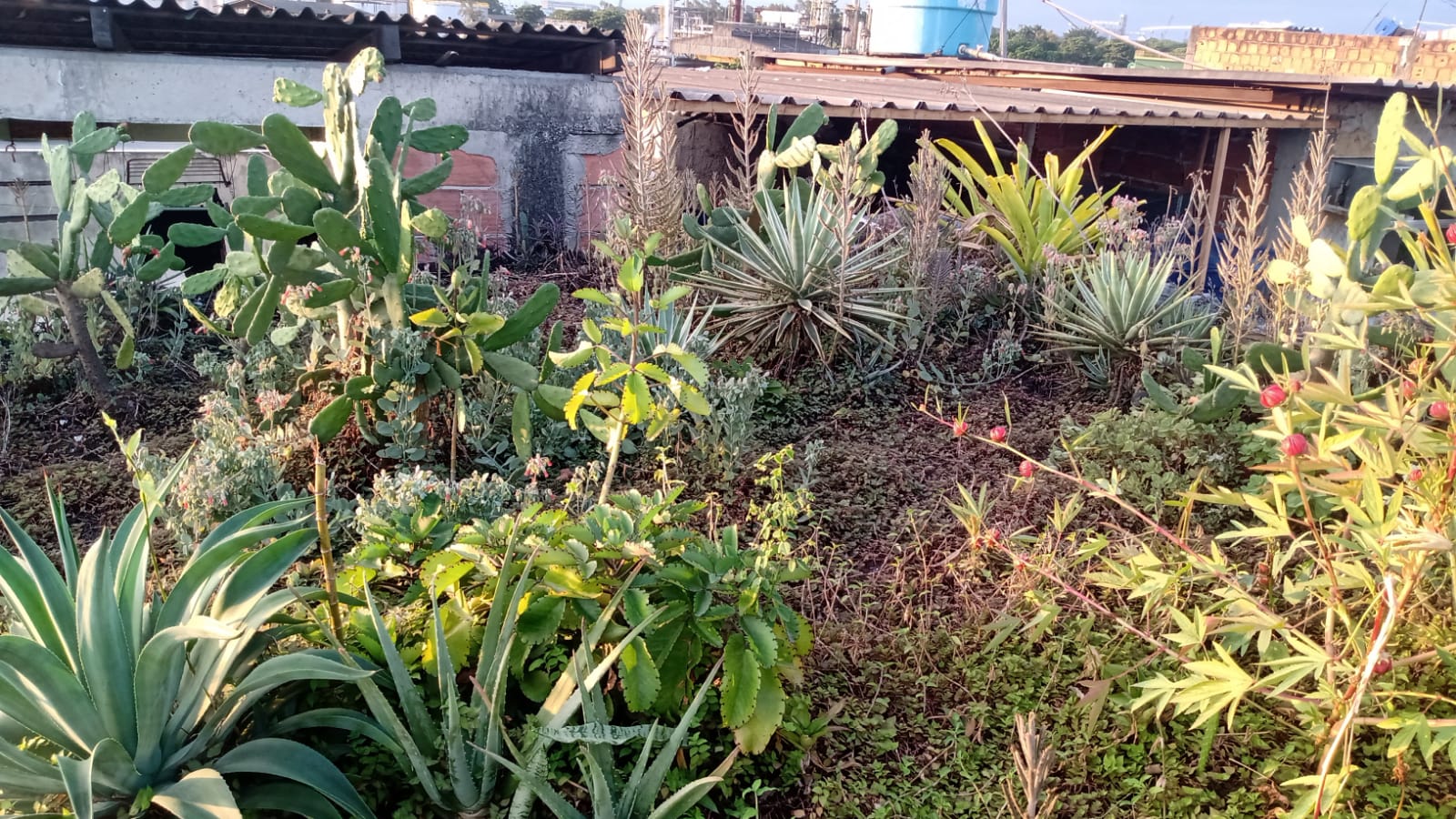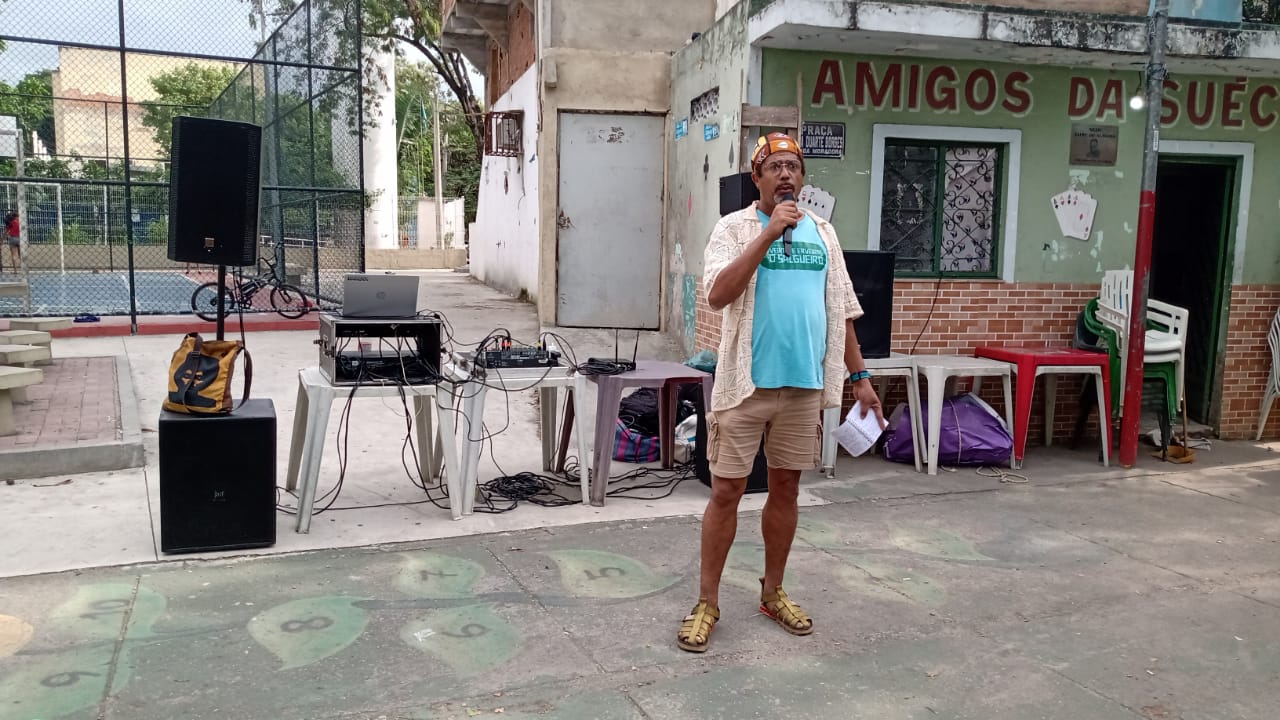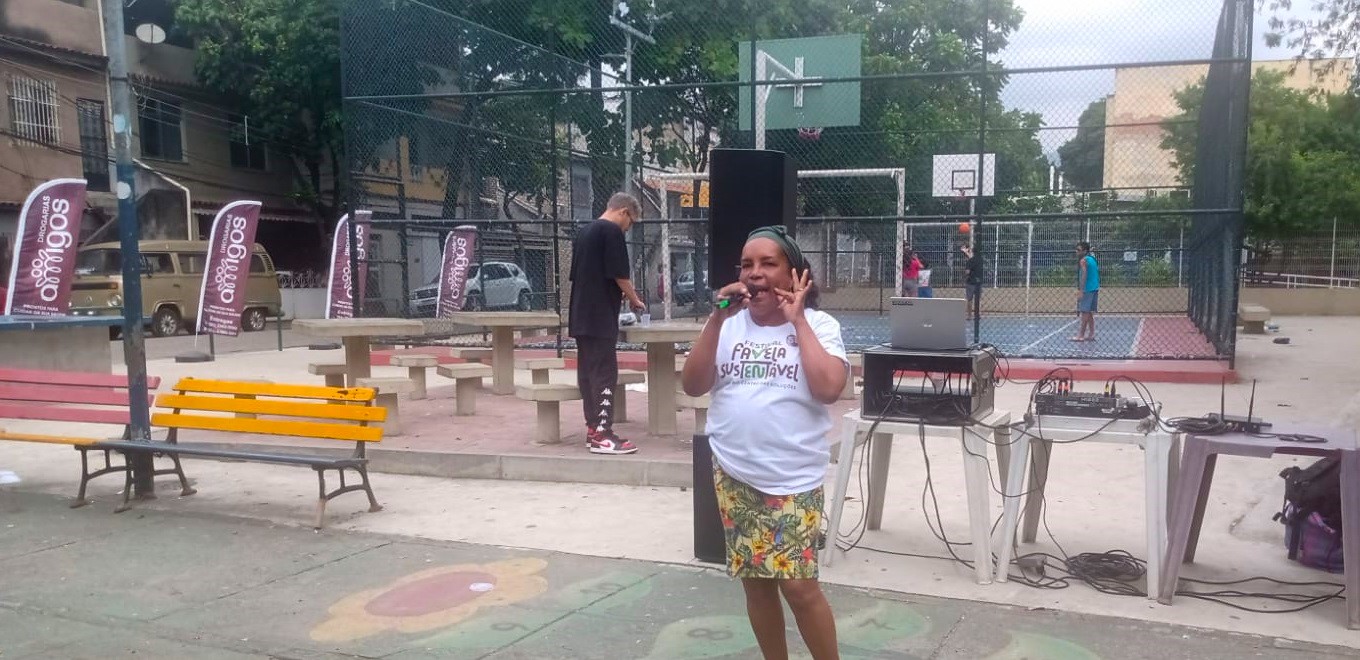
Each year, on June 21, growing numbers of people from around the world celebrate World Localization Day. In 2020, the NGO Local Futures organized the first World Localization Day. Countless citizens, initiatives and organizations are involved in localization, even if they may not use the label. Localization, put simply, has to do with reconsidering where we apply our focus: moving it close to home—to building community well-being and self-reliance through local systems for food, economy, housing, knowledge, and more. It is not about nationalism or isolationism, but about shifting awareness away from dependence on top-down globalization and toward how we can strengthen the world from the ground up: by strengthening our communities and their own ways of life and systems of production. In honor of World Localization Day 2025, RioOnWatch produced this article on the sharing of local, nature-based knowledge and technologies in the community of Parque Arará, in Benfica, Rio’s North Zone, during an event that was part of the 2025 World Localization Day calendar—an agenda recognized and celebrated in over 100 countries.
On June 7, in celebration of World Environment Day and World Localization Day, the Green Roof Favela project hosted a cultural afternoon in the Parque Arará favela, in Benfica, Rio de Janeiro’s North Zone. The Praça da Nacional (also known as Zélia Duarte Borges Square), located at the entrance to the community, was home to the event.
Around 60 people, not counting interested passers-by walking through the square, took part in the day’s activities. The event united environmentalists and community organizers like Severino Franco, from the Friends of Rocinha Ecological Park (APER); Neuza Nascimento, columnist for the social impact news site Lupa do Bem; Emerson Menezes, from the Salgueiro Favela Herb Growers collective; Claudia Queiroga, from the social gastronomy project Gastromotiva; Alê Castanheda, Tiririca, and Daniel Real, from the local initiative Arará Backyard; Valéria Santana, a researcher on the rights of nature; Sergio Anversa, environmental studies professor at Uniabeu; and Lenilza Leal, artisan and collector of recyclable materials—alongside Parque Arará residents. The program featured rap performances, a poetry jam, talks, and workshops.
Environmentalism in the ‘Language, Rhythm, and Vibe of the Favela’
Responsible for organizing the event, Green Roof Favela represents a community-based solution to urban heat islands—a phenomenon that has been worsening with the climate crisis. For Luis Cassiano Silva, who created the project in 2012, this Environment Day gathering encouraged the practice of environmental action in favelas—from simple steps like planting to more complex efforts such as building and installing green roofs.
“One day, we did an interview for [a news outlet] from France. I decided to try something new: I brought my laser thermometer out to the street and started measuring the ground, the cars, the walls—even joking with residents: ‘How hot do you think this asphalt is?’ Then people were like, ‘52°C (125.6°F), 47°C (116.6°F).’ When they saw 67°C (152.6°F), 69°C (156.2°F), they were shocked. And that’s when it hit me: you don’t see a single stray dog on the street. And usually, all that heat hits the rooftops too. These days, we use a lot of metal roofing. The heat hits those roofs and intensifies the heat wave hanging over us. I know I’m not going to fix this alone. We’re working at the micro level because there are a lot of people destroying things on a macro scale. And I get that what we’re doing is really small—but it matters a heck of a lot. It gives us a reason to feel good.” — Luis Cassiano Silva

Parque Arará is a favela located between the neighborhoods of Manguinhos and Benfica. Its proximity to Avenida Brasil—a major expressway with the highest volume of vehicular traffic in Rio—and to the Manguinhos Oil Refinery (currently called Refit Refinery)—generates heat and emits greenhouse gases, contributing to the clearly felt urban heat island in the community.
Today, Parque Arará has two public green spaces: Praça Matupiri and Praça da Nacional. Under Silva’s leadership, Praça da Nacional has become an environmental reference point in the community. There are currently five green roofs in the favela: one on Silva’s own home, three on commercial establishments, and one at the motorcycle taxi stand in Praça da Nacional. According to Silva, residents’ interest in adopting green roof technology on their homes tends to grow as strategic efforts to raise awareness around environmental issues become more widespread in the community. One of these strategic actions, he says, was the event held on June 7.

“Culture helps draw people in, so they can start picking up information. It’s a lighter way [to introduce environmental issues] than bringing in a bunch of biologists—people might not understand anything and just get bored. When I started researching green roofs, I found a way to talk about environmentalism in a way that’s not boring. That’s why it’s called Green Roof Favela—because I bring [all of it] into the language, rhythm, and vibe of the favela.” — Luis Cassiano Silva
Knowledge That Doesn’t Depend on ‘Academic Approval’
One of the activities featured at the event was a guided visit to the Lilian Cecilia community garden, built within the grounds of the Medalhista Olímpico Maurício Silva Family Health Clinic, located in Parque Arará. The visit was led by Sergio Anversa, environmental studies professor and the person responsible for the garden. The project began after the clinic identified the need to complement the treatment of its psychiatric patients, many of whom are residents of Parque Arará. Inaugurated in April 2024, the garden includes species such as aloe vera, Brazilian pepper tree, yarrow, as well as unconventional edible plants (PANCs) and corn.
“The manager at the Family Clinic asked us to do an [environmental] project, saying that many psychiatric patients were left waiting for a doctor, when there just weren’t enough. That made patients very anxious. So I proposed a garden project for the elderly. She agreed to it, but didn’t want it to be just any garden. So we came up with a philosophy for the garden: we chose food security and sustainability, and we wanted to reconnect people with their ancestral knowledge [especially of medicinal plants] by bringing their own understanding into the space. Everyone leaves their contribution.” — Sergio Anversa
At the open mic, various community organizers and activists shared their experiences, highlighting that nature offers countless solutions to the challenges faced by favelas. For Emerson Menezes, from the Salgueiro Favela Herb Growers collective, addressing this topic also contributes to the recovery of ancestral knowledge, traditionally cultivated through grassroots practices.
“I believe this knowledge has always existed and will continue to exist, regardless of whether academic knowledge approves of it. Because it’s practical, inclusive, and also due to issues of income. Sometimes, favela residents don’t have access to industrialized medicines [due to] cost. Having access to a natural remedy that you can harvest from your own garden, find in a forest area or in a community garden is a lot more interesting. At the same time, having academic institutions recognize and understand that this knowledge is effective—I think that’s also fantastic. This kind of integration is increasingly necessary, because this ancestral knowledge has been established for generations. For a long time, science dismissed it, [but] today, when we conduct [scientific] studies on these plants, we see that the properties our grandmothers talked about are now recognized by academia… Still, we always say: it’s essential to see a doctor—one thing doesn’t cancel out the other.” — Emerson Menezes

Claudia Queiroga, a solidarity cook trained through the Gastromotiva project and founder of the first School of Social Gastronomy in the neighborhood of Engenho da Rainha, commented that favelas are full of innovative ideas—but to make them a reality, effective support for entrepreneurship is essential.
“People think what we need is money, [but] it’s not. What we need is opportunity, visibility. How do we make sure that a person from the favela, who’s doing their best, gets seen? That’s the mindset we need: projects need to get out of the favela and be seen. We need to get out there and talk about them. In the project I’m part of, I have a friend who makes eco-friendly soap, but it can’t be used [and sold and distributed just anywhere] because it doesn’t have an official seal of approval. But it cleans! And we can prove that it does! So what can we do for this woman? Create opportunities for her to make the label for her soap! How can we improve someone’s life without just handing out money, without planning? It’s about really holding their hand [the whole way]!” — Claudia Queiroga

The entrepreneur insists that the favela is a specialist and must be heard in the search for solutions to its own problems. Lived experience is the best school and a key driver in the creation of effective, low-cost, and replicable solutions—like Green Roof Favela.
“When Cassiano brings up the idea of green roofs, it’s amazing to think that having greenery on your rooftop can lower the heat in these places without spending much. This kind of work transforms spaces, lives, and people. Doing it in the favela, right where people live—that’s the importance of doing favela-based business. If we’re in the favela, then this is where the power to transform is. The best places to eat, to live, are here. You transform things from the inside out.” — Claudia Queiroga
‘We’re a Collective, Nature Is a Collective’
Artists Big Papo Reto, Bocão 1313, Ed MC, João Black, and MC Tales de Mileto also took part in the event, standing in defense of the cultures that emerge from within the favelas.
“It’s really important to have events like this to raise awareness among people in the community about the environment, sustainability… Even about entrepreneurship itself, so people can learn how to earn their daily bread. Rap is a tool for transformation because, through music, we can reach people.” — MC Tales de Mileto

Tigo Conexão Penetra, a hip-hop artist and basketball art educator active in the favelas of Santa Teresa and beyond, was also present.
“The importance of this event is seeing this square looking beautiful and revitalized, with so many [plant] species all around. It’s about seeking self-knowledge and understanding how nature works—both inside and outside the human being. And knowing that we are a collective, that nature itself is a collective.” — Tigo Conexão Penetra
For rapper taPre Poetisa, born and raised in Parque Arará, introducing environmental issues through art—especially through hip-hop—can amplify solutions and broaden discussions around various problems, such as food insecurity.
“People in the favela face a lot of problems, and unfortunately, we’re not going to think about environmental issues if we’re hungry, if we don’t have clothes to wear. There are just too many problems. We get stuck in that and forget that sometimes, that same problem could be solved with a new idea. The garden at the health clinic is one way to solve it. Because, who knows—soon we might be planting and harvesting fruit [from that garden]? So in a way, we’re already addressing the issue of hunger, because healthy food is more expensive. It’s really important to have this kind of solution, to take this type of action.” — taPre Poetisa

Read below the full poem by taPre Poetisa, recited at the event organized by Green Roof Favela:
In the midst of the concrete jungle,
where all you see is brick and stone,
a flowery green roof catches your eye—
and you wonder if its owner might be losing their mind.In this ecological madness,
in this urban chaos,
where heat is relentless,
the shade of plants is a living privilege.Too bad so few can see it.
Beyond the contrast,
of gray cement
to the green of leaves,
to feel cool air instead of a heavy haze,
to feel that plants do save us from the smothering heat.
About the author: Amanda Baroni Lopes is a journalism student at Unicarioca and was part of the first Journalism Laboratory organized by Maré’s community newspaper Maré de Notícias. She is the author of the Anti-Harassment Guide on Breaking, a handbook that explains what is and isn’t harassment to the Hip Hop audience and provides guidance on what to do in these situations. Lopes is from Morro do Timbau and currently lives in Vila do João, both favelas within the larger Maré favela complex.
